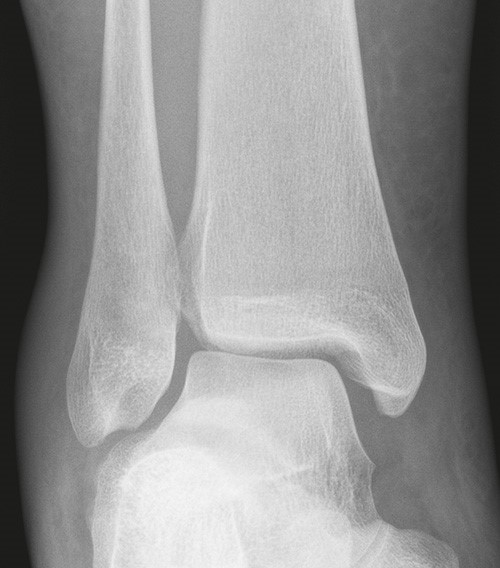Dr. Abene is a board certified Orthopaedic Surgeon. He did his Sports Medicine Fellowship at Stanford where he worked directly with the head team physicians for the San Francisco 49ers and Giants. He is currently the head team physician for the San Jose Sharks AHL affiliate, the San Jose Barracuda. He is also a volunteer team physician for USA Hockey.
Ankle Injuries
What is an ankle sprain?
Even with stiff skates, hockey players can still sprain their ankle. The ankle has multiple ligaments that help stabilize the joint. An ankle sprain involves injury to these ligaments. The main ligament that is injured in a “regular” ankle sprain is the anterior talo-fibular ligament (ATFL). It is usually torn with a twisting or inversion (ankle goes “in”) injury.
How is diagnosed?
Usually the mechanism of injury is a dead give away. The skater will have pain over the outside part of the ankle after an inversion or twisting injury. In hockey, that typically happen when the skate gets caught against the boards while being checked. X-rays are typically negative. Physical exam remains the mainstay of diagnosis and grading with tenderness directly over the ATFL.
What are the grades?
There are 3 grades of ankle sprain. They are basically, the Good, the Bad, and the Ugly. Grade one is a stretch, two is a partial tear, and three is a complete tear. A good team doc should be able to “make the call” on physical exam alone. The more severe the tear, the longer it usually takes to return to play.
How is it treated?
Anyone who has ever played sports has probably sprained their ankle. The mainstay of treatment is RICE; Rest, Ice, Compression, and Elevation. Sometimes, an air splint is involved. If the sprain is severe (grade 3) the player may wear a brace, cast, or removable fracture boot. Working with a therapist or trainer can help expedite healing.
When can I return to play?
Professional athletes are often expected to play through pain so an ankle sprain usually does not keep them out for too long, maybe 2-3 weeks. The grade of injury is a useful guide, i.e. less severe means earlier return. It also depends on the situation, because returning too early can make things worse or prolong recovery. Taping the ankle can also help. Expect at least 3-4 weeks.
What is a high ankle sprain?
This is a completely different injury. The tibia and fibula are separate bones in the leg that are held together by a structure known as the syndesmosis. The syndesmosis is a band of tissue that runs between the tibia and fibula from the ankle to the knee. High ankle sprains involve the “syndesmosis” and are much more difficult to recover from. The “energy” from the injury starts at the ankle and can go as high as the knee, thus a “high” ankle sprain.
Ok, so what is the difference between a “regular” ankle sprain and a “high” ankle sprain?
A “regular” or “low” ankle sprain involves just the ankle. A high ankle sprain can involve the whole leg from the ankle to the knee. High ankle sprains are not as common as regular/traditional sprains, but are more common in hockey compared to other sports. Think of the energy involved in a “high” ankle sprain trying to rip the fibula and tibia apart.
How are high ankle sprains diagnosed?
It is usually diagnosed by physical exam. The pain is usually higher up than a regular ankle sprain. Often times, the pain can be reproduced by rotating the ankle “out” (external rotation). There is also a “squeeze test” which involves literally squeezing the calf to see if the pain increases. An X-ray can show widening of the ankle joint. Some docs will perform a “stress” x-ray. This involves taking an x-ray while externally rotating the ankle and looking for subtle widening. Sometimes, there is a fracture in the fibula bone up by the knee. This occurs because the “energy” from the ankle injury goes “up” the leg and then “exits”, creating a fracture. MRI may help in the diagnosis but is usually not necessary.
What is the treatment for a high ankle sprain?
A good way to look at these is to compare “stable” versus “unstable” injuries. A stable injury occurs when there is no widening (or fracture) on the x-ray. This type of injury is treated with RICE. Often, the player will be treated in a removable fracture boot. If the ankle is widened, surgery may be performed. This involves putting screws or other fixation devices from the fibula into the tibia. This allows the syndesmosis to heal with the bones being “intimate” with each other.
How long will I be out with a high ankle sprain?
This is a very frustrating injury for players, coaches, and docs. It can take a long time to recover from this injury, often weeks. A study that looked at over 100 NHL players with high ankle sprains showed players were typically out for 45 days and missed 8 games. The docs and trainers work closely with the player to determine when the pain is diminished enough to play. Once there is minimal swelling and appropriate strength, a player can resume skating. The recovery time is usually about 6 weeks.
The contents of Neutral Zone and Dr Abene’s articles such as text, graphics, and images are for informational purposes only. The content is not intended to be a substitute for professional medical advice, diagnosis, or treatment. Always seek the advice of your physician or other qualified healthcare provider with any questions you may have regarding a medical condition. Never disregard professional medical advice or delay in seeking it because of something on the Neutral Zone website.
If you think you may have a medical emergency, call your doctor or 911 immediately. Neutral Zone does not recommend or endorse any specific tests, physicians, products, procedures, opinions, or other information that may be mentioned on the site. Reliance on any information provided by Neutral Zone, Dr Abene or any of its employees or other information appearing on the site is solely at your own risk.





